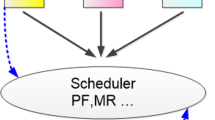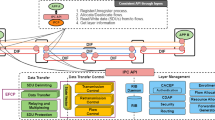Abstract
We propose a practical approach to provide QoS over the existing best-effort Commercial On The Shelf (COTS) IEEE802.11 WLANs using Layer 3 Admission Control and Adaptive Scheduling (L3-ACAS) scheme. This approach enables operators with existing large-scale WLAN deployments to offer QoS control over their networks with minimal disruption, capital expenditure (CAPEX) or infrastructure upgrade. Extensive simulation studies show that with this scheme, the total goodput, flows throughput ratio, packets delay and jitter of the real-time applications such as VoIP and real-time video can be improved significantly. We have also successfully implemented a testbed to evaluate our architecture using the existing COTS hardware and the open source Linux components.
Similar content being viewed by others
References
IEEE 802.11a W. G. (1999). Part 11: Wireless LAN Medium Access Control (MAC) and Physical Layer (PHY) specification: High-speed Physical Layer in the 5 GHz Band, Sep. 1999.
IEEE 802.11b W. G. (1999). Part 11: Wireless LAN Medium Access Control (MAC) and Physical Layer (PHY) specification: High-speed Physical Layer Extension in the 2.4 GHz Band, IEEE, Sep. 1999.
IEEE Std 802.11g/D1.1 (2001). Part11: Wireless LAN Medium Access Control (MAC) and Physical Layer (PHY) specifications: Further Higher-Speed Physical Layer Extension in the 2.4 GHz Band.
Wi-Fi technical details. http://www.btopenzone.com/help/technical-details/index.jsp.
BT lights up half a million wifi hotspots (2009). Telecoms.com, August 20, http://www.telecoms.com/13962/bt-lights-up-half-a-million-wifi-hotspots
Yilmaz O., Chen I. R. (2009) Elastic threshold-based admission control for QoS satisfaction with reward optimization for servicing multiple priority classes in wireless networks. Information Processing Letters 109(15): 868–875
Cetinkaya C. (2009) Service differentiation mechanisms for WLANs. Ad Hoc Networks 8(1): 46–62
Xiao Y., Li F.H., Choi S. (2009) Two-level protection and guarantee for multimedia traffic in IEEE 802.11e distributed WLANs. Wireless Networks 15(2): 141–161 (1022–0038)
Kim, S., Cho, Y. J., Kim Y. K. (2009). Admission control scheme based on priority access for wireless LANs. Computer Networks.
IEEE Std 802.11eTM-2005 (2005) Part 11: Wireless LAN Medium Access Control (MAC) and physical layer (PHY) specifications: Medium Access Control (MAC) Quality of Service Enhancements, November 2005.
Liu T. H., Liao W. J., Lee J. F. (2009) Distributed contention-aware call admission control for IEEE 802.11 multi-radio multi-rate multi-channel wireless mesh networks. Mobile Networks and Applications 14(2): 134–142 (1572–8153)
Yilmaz O., Chen I.R. (2009) Utilizing call admission control for pricing optimization of multiple service classes in wireless cellular networks. Computer Communications 32(2): 317–323
Zorba, N. & Verikoukis, C. (2010). A QoS-based dynamic queue length scheduling algorithm in multiantenna heterogeneous systems. EURASIP Journal on Wireless Communications and Networking, 2010.
Ming L., Hua Z., Prabhakaran B. (2010) Dynamic priority re-allocation scheme for quality of service in IEEE 802.11e wireless networks. Wireless Networks 16: 759–774
Ahmed, M., Fadeel, G. A., Ibrahim, I. I. (2010). Differentiation between different traffic categories using multi-level of priority in DCF-WLAN. Sixth Advanced International Conference on Telecommunications, pp. 262–267, 9–15 May 2010.
Pang W. L., Chieng D., Nadia N. (2009) Enhanced layer 3 service differentiation for WLAN. WSEAS Transactions on Systems 8(5): 649–658
Floyd S., Jacobson V. (1995) Link-sharing and resource management models for packet networks. IEEE/ACM Transactions on Networking 3: 365–386
Floyd, S. (1995). Notes of class-based queuing: setting parameters, informal notes, September 1995.
Floyd, S. (1995). Notes on CBQ and Guaranteed Service. Draft document, July 1995.
The Network Simulator – ns2, http://www.isi.edu/nsnam/ns.
Author information
Authors and Affiliations
Corresponding author
Rights and permissions
About this article
Cite this article
Pang, W.L., Chieng, D. & Ahmad, N.N. A Practical Layer 3 Admission Control and Adaptive Scheduling (L3-ACAS) for COTS WLANs. Wireless Pers Commun 63, 655–674 (2012). https://doi.org/10.1007/s11277-010-0157-7
Published:
Issue Date:
DOI: https://doi.org/10.1007/s11277-010-0157-7




